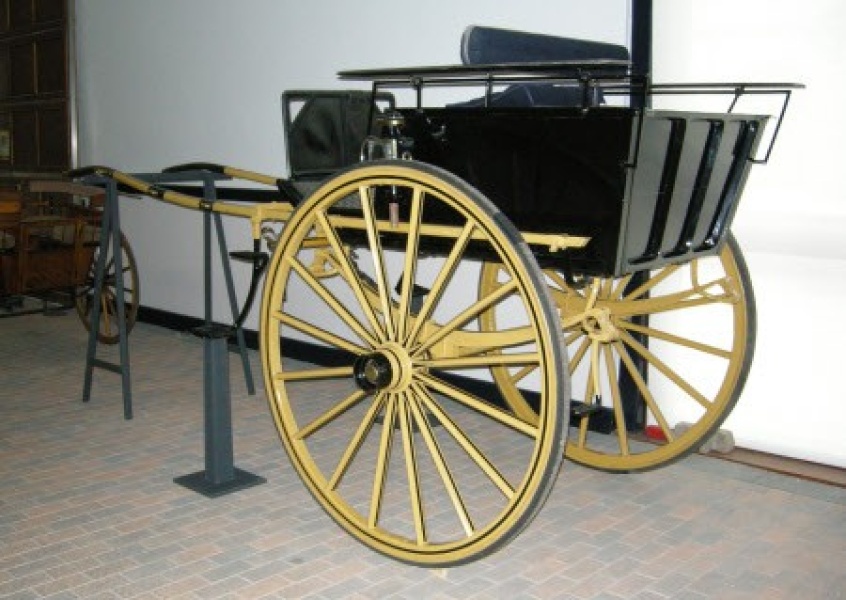Listed in 1 collection
Listed at 1 museum
Listed for 1 maker
Quick Details
Date of Production
1890
Accession or Inventory Number
ARL/CM/W/12
Materials used
Paint, Wood, Iron, Leather, Wool Box Cloth, BrassSummary of Whitechapel Cart
Whitechapel Cart built by Linington of Portsmouth circa 1890 for a single horse or a tandem. This carriage is sprung on side springs. The interior trim is in dark blue wool cloth. Painted in yellow and black with lining in black.
The Whitechapel cart is a dog cart variant identified by the panelled sides and back. The tail board can be hinged down to act as a footboard for two passengers facing backwards, as well as the driver and passenger facing forward. All two-wheeled carriages with this arrangement need to have a sliding front seat, to adjust the balance depending on the number, position and weight of the people carried. In this case there is a crank handle which can be wound to move the front seat forwards or backwards. Bright yellow and black paintwork is typical for a sporting carriage. The Whitechapel was made popular by King Edward VII who favoured this fast and versatile carriage as a smart sporting and hunting vehicle.
Dimensions
Height: 6ft 3in
Length: 6ft 3in
Width: 5ft 6 1/2in
Wheel Diameter:
Full description
This carriage is a large example of a sporting two-wheeler, ideal for the purpose for which its owner Sir Dymoke White used it – driving two of his coach horses in tandem. With the body level the underside of the shafts at the tug stops is approximately 1320mm above the ground.The body on this carriage is deeper than usual. The top of the top seat rail is 140mm above the seat boards. Whitechapel carts usually have bodies with panels that stop at the seat boards and with the top rail supported on the extended panel frames. This is a carriage made for horses of around 17hh.
The position of both the driver’s and the groom’s seat can be adjusted on slides. The driver’s seat has a screw adjustment, and the groom’s seat has bolts that engage in holes.There is a seat rail each side combined with front and back mounting handles, which also supports the wings. At some point in the past the carriage was sent to HOAD & SONS PORTSMOUTH for the body to be raised to make it more suitable for tandem driving. They increased the compass of the springs and they fitted them on 2” blocks. It is probable that they made and fitted new shafts with less lift than before. These shafts are very flat and have very little lift.
The tailboard is supported on leather straps when it is lowered, and is secured shut with spring fasteners. At the back of the carriage is a single, very shallow, grid pattern groom’s step. Double grid pattern steps are mounted on the ends of the splinter bar. On the side panels are lamp brackets that hold oval fronted lamps with a brass trim. They are a little too large for the sockets and probably do not belong to this carriage. The candle holder of the offside lamp is missing.
The wheels are 16 spoke Warner wheels with wired on rubber tyres on collinge patent axles. Unusually, the hind ends of the side springs are approximately 75mm lower than the front ends, they would normally be level. A swingle tree is suspended by two leather straps from the splinter bar, connected to the axle by leather-served chains. The shafts have adjustable tug stops and two pairs of single breeching staples
Paintwork on this Whitechapel cart is black on the body. The wheels, springs, shafts, and the metalwork below the body is yellow with a broad black line.
The dashboard, wings, leather serving for chains, shaft leathers are covered with enamelled leather. A leather covered rein clip is attached to the dashboard. Grey ribbed rubber matting covers the floor and footboard and the same is on the tailboard, with a perforated diamond pattern. An adjustable foot rest for the driver is fixed to the footboard. The box seat cushions, double-sided seat back and groom’s cushion are covered with dark blue wool cloth with dark blue seaming laces.
Inscriptions
On the axle caps: LININGTON PORTSMOUTH
On all the axle components: JOSH RICHARDS & COMPY SPRING HILL WORKS
Condition report
This carriage is in very good condition. It has been repainted in the recent past.
Access information
This Whitechapel Cart is currently in the care of The National Trust at the Arlington Court Carriage Museum.
Arlington Court,
Arlington,
near Barnstaple,
Devon,
EX31 4LP
https://www.nationaltrust.org.uk/arlington-court-and-the-national-trust-carriage-museum
Picture credit
The National trust
Christopher Nicholson/Elizabeth Jamieson

 Carriage Foundation
Carriage Foundation